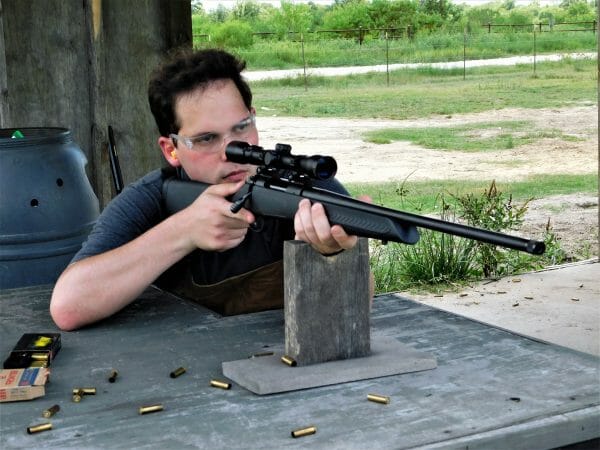
The temperatures are cooling, the days are getting shorter, and a reclusive Bambi is getting more visible. Deer season will soon be upon us if it hasn’t started in your locale yet. While fewer hunters are hitting the woods year by year, hunting rifle options continue to increase at lower and lower prices. In the past, it was not uncommon for a hunting gun to be only one gun used for decades on end without much change, but now you can get a decent hunting rifle for a few hundred dollars. This price tag used to be the realm of the single-shot rifle, but over the last ten years, budget bolt actions have flooded gun store shelves. The Savage Axis, Ruger American, Remington 770 and 783, the list goes on. Another more recent addition is the Thompson Center Compass.
Thompson Center Compass Rifle
Chambered in a popular variety of cartridges from the zippy 204 Ruger to the 300 Win. Mag, the TC Compass is ordinary in some ways and extraordinary in others, especially at its $300 price tag. The price, threading from the factory, and the rate I saw this rifle leave the shelves inspired me to get one, despite my abrasive attitude toward “hunting” rifles.
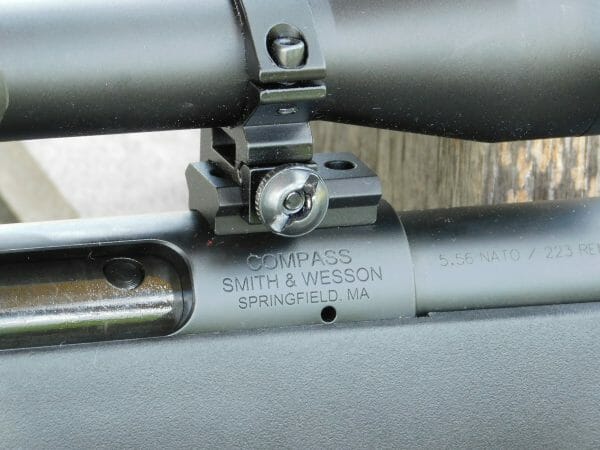
The name Thompson Center may not ring a bell to you if you are used to popular names like Marlin, Winchester, Remington, Savage, etc, etc. But that name has been around for a while and has an undercurrent of popularity. I first knew them when I made my initial forays into muzzleloading rifles. In the past, they created some of the best traditional muzzleloaders. It was only later that I figured out they made cartridge guns too. No morning hunting program on TV would be complete without some guy with a laptop and a break-action TC rifle or pistol like the Contender. Today, the company is owned by Smith & Wesson. In fact, when you look at your TC rifle, it will say that it is indeed made by Smith & Wesson.
Basic Features
From afar on the gun rack, the TC Compass can be hard to spot amongst other comparable rifles. It sports a composite stock with a trim rubber butt pad. The stock’s smooth contours are broken up by a series of unique triangular grooves on the fore-stock and pistol grip to give you something to hold onto in lieu of conventional checkering. The stock is mounted to a 22-inch tapered matte-black barrel that terminates in a knurled knob at the muzzle. This is the thread protector. Yes, the Compass comes with 1/2×28 threads right from the factory should you desire to add a suppressor or flash hider. The Compass, like most modern hunting rifles, does not sport iron sights, but instead, we get a removable weaver base mounted above the receiver.
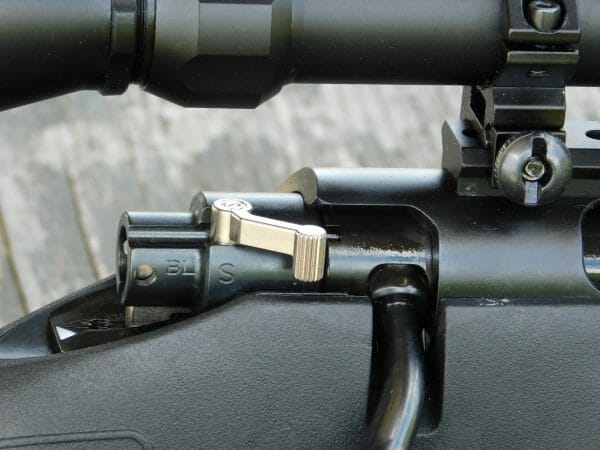
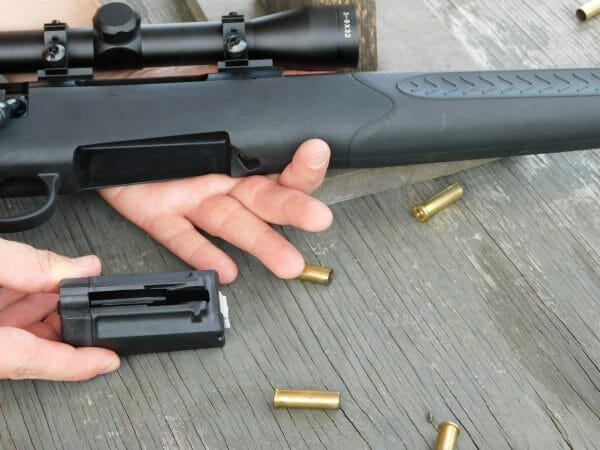
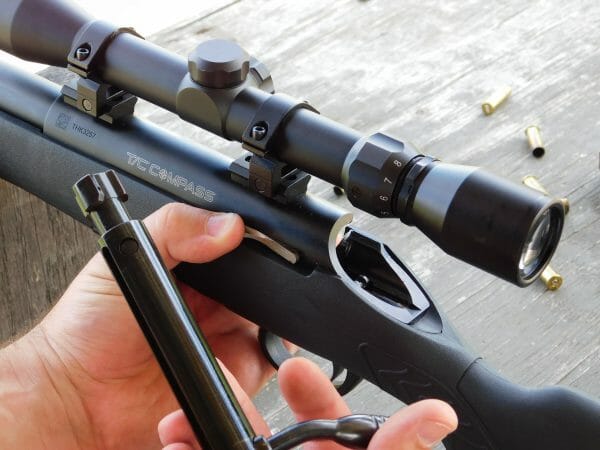
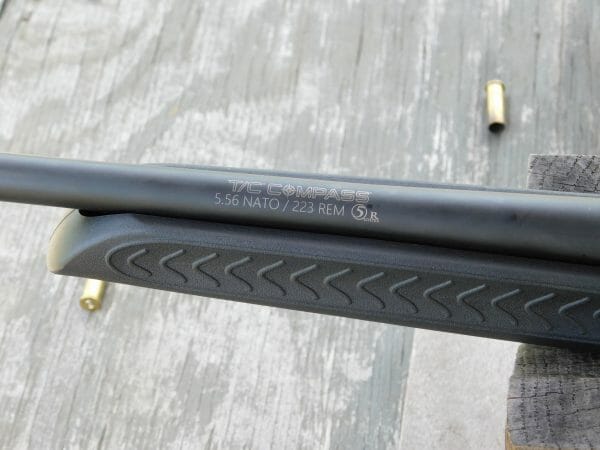
A budget-friendly bolt action hunting rifle, the Thompson Center Compass Rifle is chambered in 5.56 NATO, utilizing a 1 in 9 twist rate.
A prominent selling point of the Compass is the advertisement of Smith & Wesson incorporating 5R rifling. While I cannot attest to anything special relating to this, the Thompson Center Compass Rifle is chambered in 5.56 NATO, utilizing a 1 in 9 twist rate. I ended up going with a budget Tru-Glo 3-9×32 scope for my test–basic and budget like the Compass and optic brand elitist be damned.
On The Range
The TC Compass was the first hunting rifle I sat behind for the better part of eight years and testing went on for just as many months at distances ranging from 50 to 200 yards with a variety of ammunition and bullet weights. That ammunition included:
- Fiocchi Extrema .223 Remington 50 grain hollow-point
- Winchester 5.56mm 50 grain Frangible
- Frontier 5.56 NATO 55 grain FMJ
- Hornady Black 5.56 NATO 62 grain FMJ
- Hornady Black .223 Rem. 75-grain Boat-Tail Match hollow-point
I first sat down with the Compass to zero the optic using some el Cheapo Frontier 55-grain ammunition at fifty yards. On paper, I was in the bullseye within five rounds– and no, I did not boresight the rifle. I mounted the optic tightly and then took it out. Never rely on a factory or store boresight to be true with your given load. After that, I ejected the magazine, pressing on the wide recessed paddle at the front of the magazine well. Reloading was fast to do. The mostly-polymer magazine was buttery smooth and easy to load detached from the rifle but after prolonged sessions I often found myself loading the rifle by dropping a round into the ejection port or thumbing rounds down into the attached magazine through the port. In any case, I ended my day at two hundred yards with both Frontier and Hornady Black 62 grainers.
On paper the 55-grain ammo did better, even though Hornady’s ammunition has been very close to hand loads in previous tests. I was busting stationary clays and perforating water bottles out to two hundred yards. There was no discernable drop between the fifty-yard zero and two hundred yards–something to say about modern rifle cartridges in general. The rifle itself handled very well. Ejection was brisk, throwing the cases several feet to my right. There were no failures to feed, but sometimes I did find that the bolt dragged some when bolting forward. It sometimes felt as if there was excess movement once the bolt was fully rearward and it caused some hesitation when pushing forward again. It was enough to notice but not enough to affect performance or affect speed to make any appreciable difference. Further, there was no appreciable difference in terms of accuracy or recoil of the 55 or 62-grain ammunition.
The report was very loud–and thank goodness for earplugs. But there was no recoil at all. My view inside the scope was not disturbed at all. I could clearly see the impacts as I made them, though this may not be true in other Compass calibers–in which case that thick rubber butt pad would be a great aid. I could achieve, at best, 1.8 inches at one hundred yards with either ammunition from a bench rest. This isn’t stellar but it isn’t bad considering the rest and the not-so-good-shooter.
55 grain and 62-grain ammunition are by far the most common in the 5.56 NATO/.223 Remington offerings that the Compass can digest but the time would soon come that I would try more extreme ends of the spectrum. These rounds are at home in the varmint taking world with light, fast 35-50 grain loads and longer, range deer-worthy loads above 62 grains. It was clear at one hundred yards, the 50-grain loadings I tested did not fare well at all and even lighter loads might be pointless. Both the Fiocchi and Winchester ammunition casted a low, four to eight inch group with the Winchester taking the cake in the department of terrible. I loaded up the 75 grain Hornady match rounds thinking the rifling would be too slow to stabilize them. The 1 in 9 twist is more at home with lighter grain bullets and 1-8 or even 1-7 as optimal for heavy 75-80 grain bullets. This is a great subject of debate but it was settled when I sent those pills downrange. Over several strings, I held five round groups at 1.2 inches at worst with my best turning in .87 inch with three rounds through the same hole. Given my shaky love of coffee and inexpensive glass, I imagine some of that accuracy had to do with the rifle paired with this excellent ammunition.
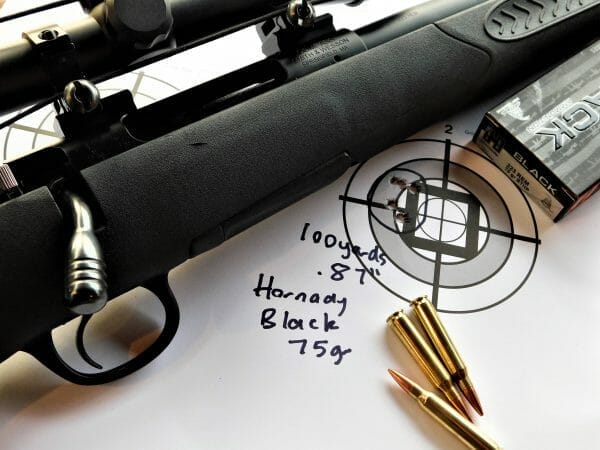
Final Thoughts
The TC Compass represents perhaps the best of the budget bolt action rifles available today. The rifle’s weight and size is not uncomfortable for a smaller-statured shooter, yet not too small for a larger-framed guy like me. The stock felt solid, and the “checkering” was not obnoxiously uncomfortable to grab onto but permitted plenty of purchase. I liked the money-saving inclusion of the pre-installed scope bases and inverted flag safety. Although I have no use for a flash hider or suppressor, I can see the benefit of having a hunting gun threaded for those options right from the factory. Accuracy was excellent for the price point, and the rifle never failed to fire.
The only downside for me is the not-so-smooth bolt work and the mostly polymer magazine. I would have preferred a stamped steel magazine–or at least a stamped steel magazine catch that would give more trust to the end user. Even so, the magazine was never a problem in the three hundred-plus rounds. The only true point of annoyance lay in the trigger. The flat-faced trigger offers no play or take-up. This is something few people would want but I do like this as a felt response to how much pressure is left before the final break, letting off a shot. Here, there is no trigger feedback, and I pull against an unmoving wall of steel until the final, clean break. Your mileage and opinions may vary as mine do. But even with my nitpicking, the Compass gets an A.
The TC Compass is a rifle loaded with features and accurate to boot. Whether you are a new sportsperson looking for your first rifle or an old hand looking for a loaner or beater gun, the TC Compass should be on your radar.
Live Inventory Price Checker
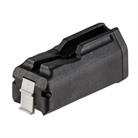
|
Thompson Center Compass Magazines | Brownells.com | $ 34.99 |
|

|
THOMPSON CENTER Compass II 338 Win Mag 24in Blue 4rd | KYGUNCO | $ 357.99 |
|

|
THOMPSON CENTER COMPASS | Guns.com | $ 475.99 |
|

|
Thompson Center Compass 6.5 Creedmoor 22-inch 5Rds w/ Leupold VX-3i 3.5-10x40 Scope | GrabAGun | $ 589.00 |
|
About Terril Hebert:
Terril Hebert is a firearm writer native to south Louisiana. Under his motto-Guns, Never Politics-he tackles firearm and reloading topics both in print and on his Mark3smle YouTube channel, where he got his start. Terril has a soft spot for ballistics testing, pocket pistols, and French rifles. When he is not burning ammo, he is indulging his unhealthy wildlife photography obsession or working on his latest novel. Scourge of God, published in 2017. See more from Terril on youtube under Mark3smle
